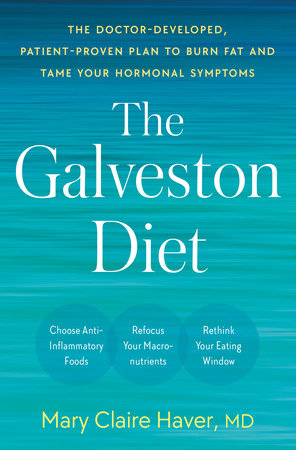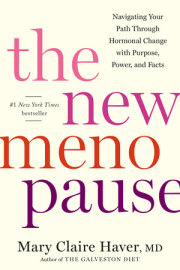Introduction From our first day of life until the last, our bodies are always changing. This is a part of aging—a natural process no one can escape. But the changes that happen to women in midlife are unique and are often unsettling. Suddenly we’re having odd symptoms like hot flashes and an accumulation of strange, new weight gain around our midsections. Our skin can be very dry or wrinkling more. We may have joint pain, hair loss, headaches, bloating, and worsening anxiety or depression. Sleep becomes elusive. Sexual intercourse can hurt. Little things set us off.
A lot of this may be happening to you right now. Trust me, you are not alone. Let me introduce you to someone who knows exactly what you’re going through: me.
I was a busy physician, a mom, and a wife in my late forties. My main health challenge at the time was polycystic ovary syndrome (PCOS), a condition caused by insulin resistance, in which insulin can’t do its job of ushering glucose into cells for energy. PCOS leads to erratic periods, acne, infertility, ovarian cysts, and unwanted hair growth.
About 1 in 10 women of childbearing age has PCOS. The majority (about 70 percent) are overweight or even obese, but I was among the 30 percent of normal weight. Fortunately, PCOS is treatable, and in my case, taking hormones greatly helped.
Then came a death in my family; I lost my brother, Bob, to liver failure. I was despondent. He was my daughters’ favorite uncle, a creative fun spirit with whom I had a special bond. We were dance partners when I was younger, winning dance competitions all over Louisiana. When he died, I was heartbroken, and losing him brought crushing pain.
Grief does strange things to each of us. For me, I coped by bingeing. Night after night after long clinic shifts, I stood in front of my pantry, gobbling handfuls of Goldfish crackers. I’d wash them down with glasses of wine. Pretty quickly I gained nearly 20 pounds. I looked like a different person, and I felt miserable.
With my medical background, I knew that at my age it might be time to come off the hormones for a while. So, I talked to my own doctor, and we agreed that I should.
But taking the hormones had masked the perimenopausal symptoms that occur during midlife, so within two weeks of being off them, everything abruptly changed—and not for the better. I had hot flashes and I felt like I was burning from the inside out. Along came sleepless nights and, most troubling of all, the fuzzy and forgetful feeling called brain fog. My long, thick hair started falling out by the brushful. My skin felt parched from head to toe, and I had to completely change my skincare routine to keep my skin moisturized. My body ached so much that I kidded with a friend that I’d give up my firstborn to get relief. My sleep became a recurring nightmare of multiple awakenings through the night—at first drenched in sweat, and then freezing once the hot flash passed.
I knew I was going through a period of hormonal change—perimenopause—but the symptoms it produced were so profoundly intense that I was really alarmed. All this
on top of the weight gain? I was a mess.
Then I heard my brother Bob’s voice in my head. “Girl, you don’t have to wallow in this anymore. You got yourself into this; you can get yourself out.”
I went to work on my weight first. I did exactly what I and other doctors had always counseled patients to do: eat less, exercise more.
My efforts paid off, sort of. I’d lose a pound or two, but that was it. Then the weight would come right back on. I was starving myself and working out obsessively, but hardly dropping any weight. It was very frustrating. I just wanted to fix me, but nothing I did or tried was sticking.
I realized that I was struggling with the same weight issues many of my patients had told me about. They would sit in the examining room, often clutching paper gowns, and ask for advice about losing weight, frustrated with the fact that they had changed their diet and exercise habits and yet the scale kept moving in the wrong direction. I’d spend the next several minutes speaking with them about the combined power of diet and exercise. But for the majority of these women at this age, what I had been taught, and what had worked for me in the past, stopped working. They had fought for years to shed stubborn weight, without much permanent success. I’m sorry that it took having this same thing happen to me to change my tune, but that’s the truth. When my own good advice didn’t help me, it really hit me that I was doing something wrong.
I then threw myself into researching weight management and human metabolism—specifically as they relate to women. Medical school and my OB-GYN residency had taught us “calories in/calories out” as the only way, but clearly there had to be another. I didn’t have all the answers, but I wanted them—so I could feel better myself and then I could guide and teach women how to reach the weight, the energy level, and the good health they want and deserve. I yearned to understand why we have such a tough time losing weight and keeping it off, especially as we approach and enter midlife.
My deep passion for finding answers, combined with motivation and determination, took me to some unexpected and exciting places. What kept popping up in the research were three themes: intermittent fasting, anti-inflammatory nutrition to help manage our hormonal changes, and important new science on the exact ratios of protein, carbohydrates, and fat we need to consume to burn fat.
Could these be the keys?
I decided to create my own plan using these three principles. That’s when my individual health journey began. I tried out the newly minted diet on myself first. I focused on timing first and then gradually started intermittent fasting. After I mastered that, I focused on content: I began to eat more protein and fiber. I used olive oil, avocado, nuts, and seeds as my principal sources of fat. I steered clear of refined, processed carbohydrates (no more Goldfish crackers!). I restricted foods and ingredients like artificial colors and flavors that promote inflammation and disrupt the gut. What I
never did was
count calories. Next, I further refined the macronutrient percentages to supply more fat, moderate amounts of protein, and fewer carbohydrates.
Within several months, I lost those 20 pounds—especially around my abdomen. I was ecstatic but quickly realized the weight loss was just a pleasant side effect. More important, I felt healthier, stronger, and more energetic. My hot flashes dramatically diminished, and I was sleeping better.
I was on to something, so I asked my friends to try it. As I had been, they also were amazed about the pounds and inches they were losing. Best of all, they agreed this was easy. We didn’t feel hungry all the time. No cravings. No terrible feelings of deprivation or restriction.
Next, I made copies of this three-tiered plan and handed them out to my patients. There were the same results: weight loss, fewer menopause symptoms, and more energy. Plus, they were keeping the lost pounds off, something they’d never been able to do on any of their many previous diets.
After seeing these success stories, I felt it was time to share my plan with a wider audience. I launched the initial program on Facebook for free and asked volunteers to try it. Word then spread that people were losing significant amounts of weight, including belly fat. I then wanted everyone to have access to its secrets and experience its success.
I further formalized the plan and took it to an even broader audience through an online program. Not sure of what would happen, I noticed that women began enrolling in the plan, week after week, and we were off and running. I have to admit, I was astonished to see how popular the program had become in such a short time. It was the medical diet everyone was talking about.
Enrollment in the program further skyrocketed, and to date, the plan has now helped tens of thousands of women shed unwanted pounds, shrink their waistlines, and improve their health. I named my diet after Galveston, a coastal resort town in Texas. Although I wasn’t born there, my husband and I have raised our daughters in Galveston. I call it home, and it is where I’ve spent much of my medical career. Now it is the birthplace of
The Galveston Diet! After the program took off, I wanted to further sharpen my nutrition knowledge. I enrolled in the prestigious Culinary Medicine Program at Tulane University, in Louisiana. It educates and trains doctors and other medical professions to understand and apply medical nutrition principles in a practical manner. That way, we can help our patients with nutritional modifications that improve their health.
Sixty hours of coursework and many hands-on labs later, I was certified in 2019 as a Culinary Medicine Specialist. The experience solidified and affirmed that I was on the right path with what I had developed for
The Galveston Diet, particularly the importance of anti-inflammatory nutrition. The course also emphasized something that really stuck with me:
Nutrition is the most under-utilized medication, yet it is the most effective. So here I am today, humbled and gratified that so many women are
finally achieving what they’ve always wanted: a beautifully fit body on the outside and an incredibly healthy one on the inside.
Copyright © 2023 by Mary Claire Haver, MD. All rights reserved. No part of this excerpt may be reproduced or reprinted without permission in writing from the publisher.








